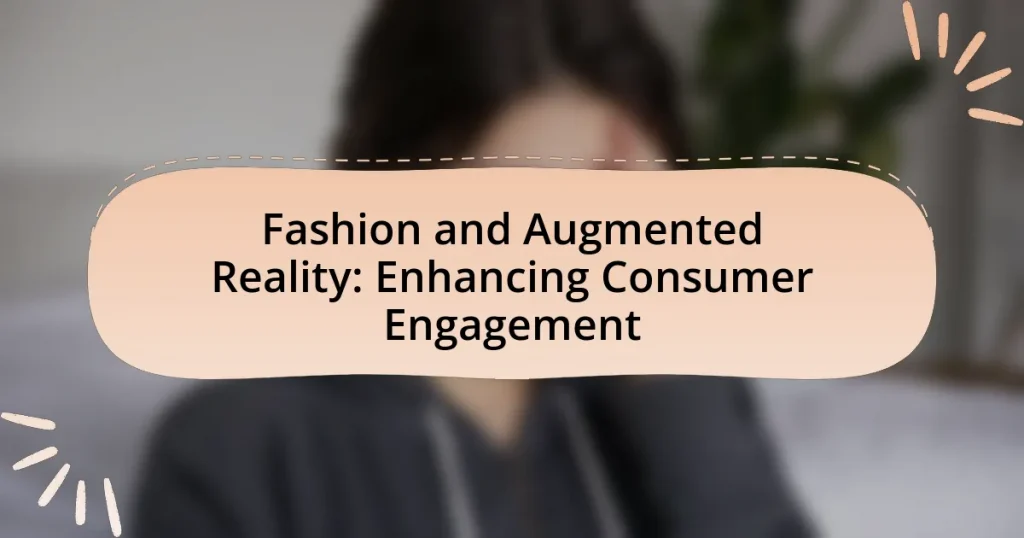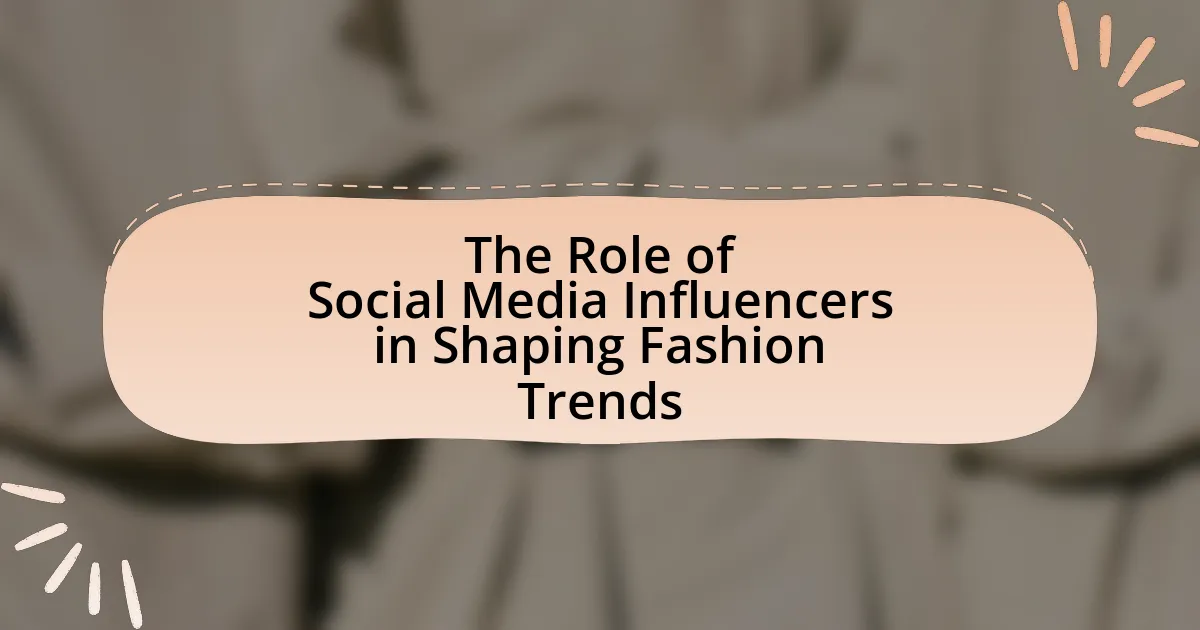Fashion and Augmented Reality (AR) represent the convergence of digital technology and the fashion industry, enabling consumers to engage with clothing and accessories through interactive virtual experiences. This article explores how AR enhances consumer engagement by facilitating virtual try-ons, improving shopping experiences, and increasing sales conversion rates. Key technologies such as computer vision and 3D modeling are discussed, along with the importance of consumer engagement in driving brand loyalty. Additionally, the article highlights successful examples of AR applications in retail, best practices for implementation, and future trends that indicate a growing reliance on AR in fashion marketing strategies.
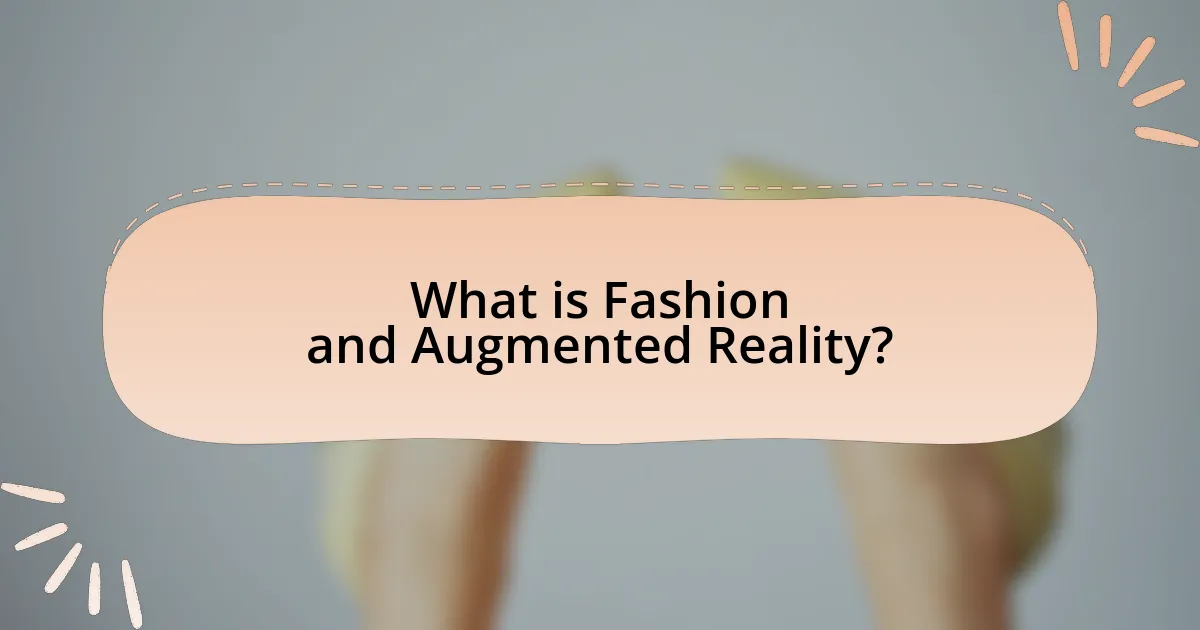
What is Fashion and Augmented Reality?
Fashion and Augmented Reality (AR) refers to the integration of digital technology into the fashion industry, allowing consumers to experience clothing and accessories in an interactive and immersive way. This technology enables users to visualize how garments will look on them through virtual try-ons, enhancing the shopping experience by providing a realistic representation of products without the need for physical samples. Research indicates that AR can increase consumer engagement and satisfaction, with studies showing that 61% of consumers prefer retailers that offer AR experiences, as it helps them make more informed purchasing decisions.
How does Augmented Reality integrate with the fashion industry?
Augmented Reality (AR) integrates with the fashion industry by enabling virtual try-ons and immersive shopping experiences. This technology allows consumers to visualize clothing and accessories on themselves through their devices, enhancing engagement and reducing return rates. For instance, brands like Gucci and Zara have implemented AR features in their apps, allowing users to see how items look in real-time. According to a study by the National Retail Federation, 61% of consumers prefer retailers that offer AR experiences, demonstrating its effectiveness in attracting and retaining customers.
What technologies are used in Augmented Reality for fashion?
Augmented Reality (AR) in fashion primarily utilizes technologies such as computer vision, depth tracking, and 3D modeling. Computer vision enables the recognition of real-world objects and environments, allowing virtual elements to be seamlessly integrated. Depth tracking enhances the realism of AR experiences by accurately mapping the spatial dimensions of the user’s surroundings. Additionally, 3D modeling is essential for creating lifelike representations of clothing and accessories, enabling virtual try-ons. These technologies collectively enhance consumer engagement by providing interactive and immersive shopping experiences, as evidenced by brands like Gucci and Zara implementing AR features in their mobile applications to boost customer interaction and satisfaction.
How do these technologies enhance the shopping experience?
Augmented reality (AR) technologies enhance the shopping experience by providing interactive and immersive environments that allow consumers to visualize products in real-time. For instance, AR applications enable customers to virtually try on clothing or accessories, which increases engagement and reduces the likelihood of returns. According to a study by the Harvard Business Review, retailers that implemented AR saw a 40% increase in conversion rates, demonstrating the effectiveness of these technologies in driving sales and improving customer satisfaction.
Why is consumer engagement important in fashion?
Consumer engagement is crucial in fashion because it drives brand loyalty and influences purchasing decisions. Engaged consumers are more likely to share their experiences, leading to increased word-of-mouth marketing, which is vital in a competitive industry. According to a study by McKinsey, brands that effectively engage their customers can see a 10-20% increase in sales. Additionally, consumer engagement fosters a deeper emotional connection with the brand, enhancing customer retention and lifetime value. This connection is particularly important in fashion, where trends and consumer preferences shift rapidly.
What role does consumer engagement play in brand loyalty?
Consumer engagement significantly enhances brand loyalty by fostering emotional connections between consumers and brands. Engaged consumers are more likely to develop trust and commitment, which are critical components of loyalty. Research indicates that brands with high consumer engagement levels see a 23% increase in customer retention rates, demonstrating that active participation in brand experiences leads to stronger loyalty. Furthermore, engaged consumers often advocate for the brand, influencing others and creating a community around the brand, which further solidifies loyalty.
How can Augmented Reality improve consumer engagement metrics?
Augmented Reality (AR) can significantly improve consumer engagement metrics by providing immersive and interactive experiences that enhance product visualization. For instance, AR allows consumers to virtually try on clothing or accessories, leading to increased time spent on platforms and higher conversion rates. A study by Deloitte found that 40% of consumers are willing to pay more for a product if they can experience it through AR, demonstrating its effectiveness in driving engagement. Additionally, brands utilizing AR have reported up to a 70% increase in customer interaction, showcasing how AR can transform traditional shopping into a more engaging and personalized experience.
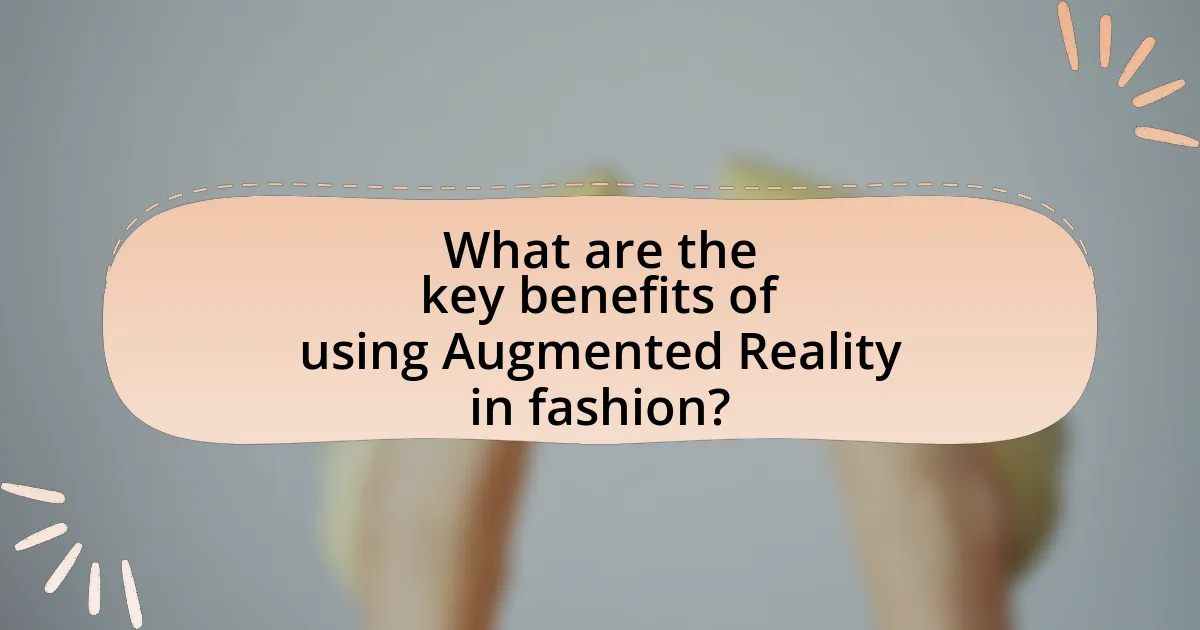
What are the key benefits of using Augmented Reality in fashion?
The key benefits of using Augmented Reality (AR) in fashion include enhanced consumer engagement, improved shopping experiences, and increased sales conversion rates. AR allows customers to virtually try on clothing and accessories, which significantly reduces the uncertainty associated with online shopping. According to a study by Deloitte, 40% of consumers are willing to pay more for a product if they can experience it through AR. Additionally, AR can provide personalized recommendations based on user preferences, further driving customer satisfaction and loyalty. This technology not only enriches the shopping experience but also helps brands differentiate themselves in a competitive market.
How does Augmented Reality enhance the online shopping experience?
Augmented Reality (AR) enhances the online shopping experience by allowing consumers to visualize products in their real-world environment before making a purchase. This technology enables users to see how clothing fits, how furniture looks in their home, or how makeup appears on their skin, thereby reducing uncertainty and increasing confidence in buying decisions. According to a study by Deloitte, 40% of consumers reported that they would be willing to pay more for a product if they could experience it through AR, highlighting its effectiveness in driving sales and improving customer satisfaction.
What features of Augmented Reality contribute to a better online experience?
Augmented Reality (AR) features such as virtual try-ons, interactive product visualization, and immersive storytelling significantly enhance the online shopping experience. Virtual try-ons allow consumers to visualize how clothing or accessories will look on them, increasing confidence in purchase decisions. Interactive product visualization enables users to see products in 3D and from various angles, providing a more comprehensive understanding of the item. Immersive storytelling engages consumers by creating a narrative around the product, fostering emotional connections. These features have been shown to increase consumer engagement and satisfaction, as evidenced by a study from the Harvard Business Review, which found that AR can lead to a 40% increase in conversion rates in online retail.
How do virtual try-ons influence purchase decisions?
Virtual try-ons significantly influence purchase decisions by enhancing consumer confidence and reducing uncertainty. Research indicates that 70% of consumers are more likely to purchase a product after using a virtual try-on feature, as it allows them to visualize how items will look on them before committing to a purchase. This technology addresses the common issue of fit and style mismatches, which are often barriers to online shopping. By providing a more interactive and personalized shopping experience, virtual try-ons lead to higher conversion rates and lower return rates, ultimately benefiting retailers and consumers alike.
What impact does Augmented Reality have on in-store experiences?
Augmented Reality (AR) significantly enhances in-store experiences by providing interactive and immersive shopping environments. AR allows customers to visualize products in real-time, such as trying on clothing virtually or seeing how furniture fits in their home space. According to a study by Deloitte, 40% of consumers are willing to pay more for a product if they can experience it through AR, indicating that AR not only improves customer engagement but also drives sales. Furthermore, retailers using AR have reported increased foot traffic and longer dwell times, as customers are drawn to the innovative technology that enriches their shopping journey.
How can retailers use Augmented Reality to attract customers?
Retailers can use Augmented Reality (AR) to attract customers by providing immersive shopping experiences that enhance product visualization. For instance, AR applications allow customers to virtually try on clothing or accessories, significantly increasing engagement and reducing return rates. A study by Deloitte found that 40% of consumers are willing to pay more for a product if they can experience it through AR. Additionally, retailers like IKEA utilize AR to enable customers to visualize furniture in their own homes, leading to a 200% increase in conversion rates. This integration of AR not only captivates customers but also fosters a more informed purchasing decision, ultimately driving sales.
What are some successful examples of in-store Augmented Reality applications?
Successful examples of in-store Augmented Reality applications include IKEA’s Place app, which allows customers to visualize furniture in their homes before purchase, and Sephora’s Virtual Artist, enabling users to try on makeup virtually. IKEA’s Place app has been downloaded over 8 million times, demonstrating its effectiveness in enhancing customer engagement and decision-making. Sephora’s Virtual Artist has increased customer interaction and sales, with reports indicating that users who engage with the AR feature are more likely to make a purchase. These applications illustrate how AR technology can significantly improve the shopping experience in the fashion and retail sectors.
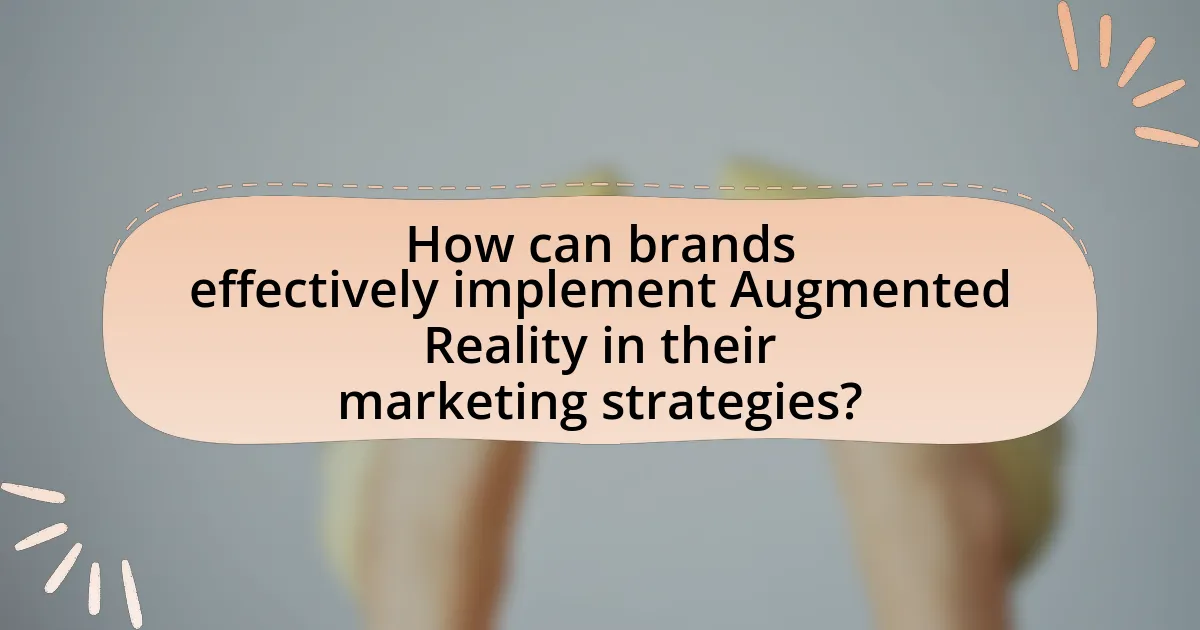
How can brands effectively implement Augmented Reality in their marketing strategies?
Brands can effectively implement Augmented Reality (AR) in their marketing strategies by integrating interactive experiences that enhance consumer engagement and provide immersive product visualization. For instance, fashion brands can utilize AR applications that allow customers to virtually try on clothing and accessories, significantly improving the shopping experience. According to a study by Deloitte, 40% of consumers are willing to pay more for a product if they can experience it through AR, demonstrating its potential to drive sales. Additionally, brands can leverage social media platforms that support AR filters, enabling users to share their experiences, which can amplify brand visibility and consumer interaction. By focusing on user-friendly interfaces and ensuring seamless integration with existing marketing channels, brands can maximize the effectiveness of AR in their strategies.
What are the best practices for integrating Augmented Reality into fashion marketing?
The best practices for integrating Augmented Reality into fashion marketing include creating immersive experiences, ensuring user-friendly interfaces, and leveraging social media platforms. Immersive experiences allow consumers to visualize products in real-world settings, enhancing their engagement and decision-making process. User-friendly interfaces are crucial, as they ensure that consumers can easily navigate AR features without frustration, which can lead to higher conversion rates. Additionally, leveraging social media platforms for AR campaigns can significantly increase reach and engagement; for instance, brands like Gucci and Dior have successfully utilized AR filters on Instagram to allow users to virtually try on products, resulting in increased brand interaction and sales.
How can brands measure the success of their Augmented Reality campaigns?
Brands can measure the success of their Augmented Reality campaigns through key performance indicators (KPIs) such as user engagement, conversion rates, and customer feedback. User engagement can be quantified by tracking metrics like the duration of interaction with the AR experience and the number of users who participate. Conversion rates can be assessed by analyzing the percentage of users who make a purchase after engaging with the AR content. Customer feedback can be gathered through surveys and social media sentiment analysis, providing qualitative insights into user satisfaction and brand perception. These metrics collectively offer a comprehensive view of the campaign’s effectiveness in enhancing consumer engagement within the fashion industry.
What common challenges do brands face when adopting Augmented Reality?
Brands face several common challenges when adopting Augmented Reality (AR), including high development costs, technical limitations, and user adoption issues. High development costs can deter brands from investing in AR, as creating quality AR experiences often requires significant financial resources and expertise. Technical limitations, such as device compatibility and software integration, can hinder the seamless implementation of AR solutions. Additionally, user adoption issues arise when consumers are unfamiliar with AR technology or lack access to compatible devices, which can limit the effectiveness of AR campaigns. These challenges collectively impact the successful integration of AR in brand strategies within the fashion industry.
What future trends can we expect in Fashion and Augmented Reality?
Future trends in fashion and augmented reality include increased integration of virtual try-ons, personalized shopping experiences, and enhanced interactive marketing campaigns. Virtual try-ons allow consumers to visualize clothing on themselves through AR technology, significantly improving online shopping experiences. A report by Gartner predicts that by 2025, 75% of consumers will use AR for shopping, indicating a strong shift towards personalized and immersive retail environments. Additionally, brands are leveraging AR for interactive marketing, such as virtual fashion shows and gamified experiences, to engage consumers more effectively. This trend is supported by the growing consumer demand for innovative and engaging shopping experiences, as highlighted by a survey from Deloitte, which found that 40% of consumers are more likely to purchase from brands that offer AR experiences.
How might advancements in technology shape the future of Augmented Reality in fashion?
Advancements in technology will significantly enhance Augmented Reality (AR) in fashion by improving user experience and personalization. For instance, developments in artificial intelligence and machine learning enable more accurate virtual fitting rooms, allowing consumers to visualize how clothing fits and looks on them in real-time. According to a report by Deloitte, 40% of consumers are more likely to purchase clothing after using AR technology, demonstrating its effectiveness in driving sales. Additionally, improvements in mobile device capabilities and 5G connectivity will facilitate seamless AR experiences, making it easier for brands to engage consumers through interactive marketing campaigns. These technological advancements will ultimately transform how consumers interact with fashion brands, leading to increased engagement and sales.
What consumer behaviors are likely to evolve with Augmented Reality in fashion?
Consumer behaviors likely to evolve with Augmented Reality (AR) in fashion include increased online shopping engagement, enhanced personalization, and a shift towards experiential purchasing. AR technology allows consumers to virtually try on clothing and accessories, leading to higher confidence in purchase decisions and reduced return rates. According to a study by Deloitte, 40% of consumers expressed interest in using AR for shopping, indicating a significant shift towards integrating digital experiences in the fashion retail process. This evolution is further supported by the fact that brands utilizing AR have reported up to a 200% increase in conversion rates, showcasing the effectiveness of AR in transforming consumer interactions with fashion products.
What practical tips can brands follow to enhance consumer engagement through Augmented Reality?
Brands can enhance consumer engagement through Augmented Reality (AR) by creating interactive and immersive experiences that allow users to visualize products in real-time. For instance, implementing AR try-on features enables consumers to see how clothing or accessories look on them before making a purchase, which can increase conversion rates. According to a study by Deloitte, 40% of consumers are willing to pay more for a product if they can experience it through AR. Additionally, brands should leverage social media platforms to share AR content, as 70% of consumers report that they are more likely to engage with brands that use AR in their marketing. Furthermore, providing personalized AR experiences based on user preferences can significantly boost engagement, as tailored content resonates more with consumers.
